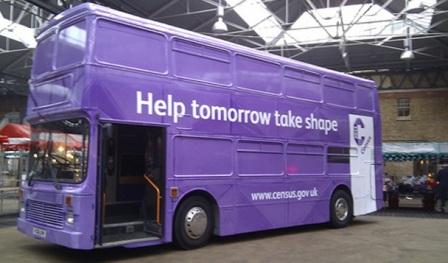Census 2011: colour it purple
The first TV advertisements for the 2011 Census will appear tonight in a high-stakes £4.5 million campaign designed to mobilise the willing and convince the reluctant that the Census matters to them.
Under the slogan “help tomorrow take shape”, the campaign focuses around purple origami folding itself into the shapes of hospitals and buses, to emphasise that counting the population is the key to delivering public services in a fair and proportionate way.
In a world increasingly reluctant to fill in forms, conducting a “long-form” Census is a gamble. This time, for the first time, it will be possible to completes the 32-page form electronically, which ONS hopes will account for a quarter of the returns and enable it to get an early idea of likely coverage.
The purple theme matches the colour of the forms, and a purple bus will be visiting 11 English cities in the run-up to Census day on March 27. (Scotland and Wales are responsible for their own censuses). Yesterday the bus was in Spitalfields Market in London – appropriately enough, as the area has seen successive waves of immigration ever since the Huguenots arrived there in the 17th century, and tracking down immigrant communities is one of the toughest tasks the Census faces.

The 2011 Census bus at Spitalfields today
Refusniks who have not returned their forms will be traced by an army of 35,000 temporary workers who will come knocking on their doors. But tracking everybody will be impossible: the Census aims at a 94 per cent return, the same as was achieved in 2001.
This time at least two small organisations, NO2ID and Big Brother Watch, will be urging civil disobedience, in spite of the £1,000 fine that can be levied for failure to complete the form.
Yesterday Daniel Hamilton, campaign director of Big Brother Watch, proclaimed the Census “a monumental waste of time and money” – a view not very different from that of Francis Maude, the Cabinet Office minister, when he was in opposition. Mr Maude has now swallowed his doubts but made clear that he expects ONS to have devised an alternative, using administrative information such as the electoral roll, GP records, tax returns and school enrolments, to replace the Census otherwise have been due in 2021.
Mr Hamilton said today that the threat of a fine was entirely hollow. “Back in 2001, three million people refused to comply. Given that there were fewer than 100 prosecutions for not filling the forms in, it’s pretty clear that non-compliance comes pretty well without repercussions.
“Last time 390,000 people declared their religion as Jedi. There’s no reason to suppose that people will take the Census any more seriously this year.”
The ONS, naturally, hopes not. The first stage of its campaign aims to build awareness. It will be followed on March 18, after the Census forms have started dropping on to the door mat, with ads that encourage people to complete them. The third phase, beginning on 7 April, will back the census collectors who by then will be visiting households which have yet to respond.
For the first time, the Census has employed Community Advisers to try to improve the response from minority communities, far greater in numbers than they were in 2001. In some areas this will be a daunting task, as social research by ESRO (Ethnographic Social Research Options) a London-based consultancy, makes clear.
ESRO found that some immigrant communities live in near-isolation from the state. “Many Chinese migrants will not interact in any way with forms or bureaucracy” they reported in 2007 in a survey commissioned by the City of Westminster.
Even the term “household” is meaningless to Chinese immigrants who live in crowded rooms provided by their employers, a transient population reliant on Chinese connections to negotiate their passage. Many deputise others better-versed in the UK traditions to pay their bills or to complete unavoidable forms. Few register with GPs.
Westminster may be untypical and the Chinese an extreme example, but getting a proper handle on the size of immigrant communities will be very difficult. William Wong, one of two Chinese Community Advisers for London, was in Spitalfields Market today. His task is to motivate the Chinese communities in Barnet, Islington and Tower Hamlets.
“It’s a big challenge” he told me. “The Chinese community is scattered, it isn’t linked by places of worship like, say, the Muslim community is, and it doesn’t use mainstream services such as GPs and libraries.
“So I plan to approach them by going to the places where they make a living – restaurants and shops, and the four major Chinese food markets in London. I also need to recruit volunteers who speak English and one of the Chinese languages to help me.”
He’s hoping that Middlesex University, where a lot of Chinese students study, may provide a source. “I hope to recruit 20 to 30” he said. So far, though, most of his volunteers are British students of Chinese, who maybe see this as a way of improving their language skills.
For those in doubt about how to fill in the forms, there’s a helpline (with 56 different languages) available from 4 March (0300 0201 101) or online help at www.census.gov.uk.




terry fitzpatrick (not verified) wrote,
Wed, 23/02/2011 - 17:22
I hope that everyone will register, there is nothing sinister about all this and it will give the lie to racists like Simon Wooley of Operation Black Vote that a third of the population of London is black.